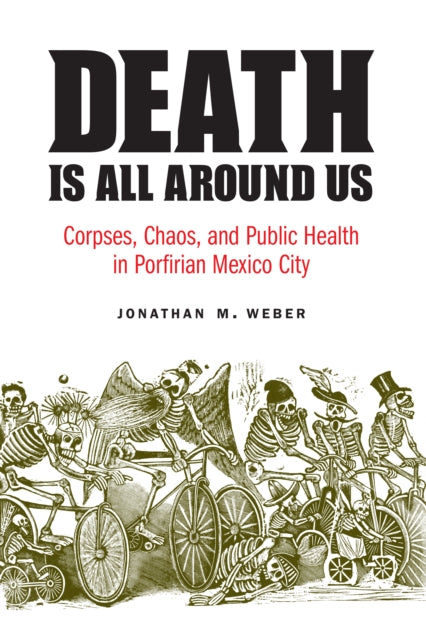Jonathan M. Weber
Death Is All around Us: Corpses, Chaos, and Public Health in Porfirian Mexico City
Death Is All around Us: Corpses, Chaos, and Public Health in Porfirian Mexico City
YOU SAVE £4.01
- Condition: Brand new
- UK Delivery times: Usually arrives within 2 - 3 working days
- UK Shipping: Fee starts at £2.39. Subject to product weight & dimension
Bulk ordering. Want 15 or more copies? Get a personalised quote and bigger discounts. Learn more about bulk orders.
Couldn't load pickup availability
- More about Death Is All around Us: Corpses, Chaos, and Public Health in Porfirian Mexico City
In 1876, one out of every nineteen people died prematurely in Mexico City, making it one of the most unsanitary places in the Western Hemisphere. President Porfirio Díaz used new forms of technology and scientific knowledge to reduce the high mortality rate and persuade citizens and foreigners that the capital city was capable of resolving the hygienic issues plaguing the city. This became a powerful weapon for controlling the behavior of its citizens.
Format: Paperback / softback
Length: 294 pages
Publication date: 01 April 2019
Publisher: University of Nebraska Press
Late nineteenth-century Mexico was a country plagued with numerous health problems. In 1876, a staggeringly high rate of premature deaths was observed in Mexico City, compared to other major Western world capitals of the time. London had a premature death rate of one out of fifty-two, Paris of one out of forty-four, and Madrid of one out of thirty-five. It is not an exaggeration to assert that dozens of bodies could be found scattered throughout the streets of Mexico City on a daily basis, making it one of the most unsanitary places in the Western Hemisphere.
In response to these alarming scenes, Jonathan M. Weber delves into how Mexican state officials, including President Porfirio Díaz, attempted to address the public health challenges facing the city. By reducing the high mortality rate, state officials aimed to elevate Mexico City's status as a modern and viable capital in North America. To achieve this goal, the government employed innovative technologies and scientific knowledge to address the thousands of unidentified and unburied corpses found in hospital morgues, cemeteries, and on the streets.
Weber's book explores the central question of how the government utilized the latest technological and scientific advancements to persuade citizens and foreigners alike that Mexico City was capable of resolving the hygienic issues plaguing the city. He examines how the state's attempts to exert control over procedures of death and burial became a powerful weapon for controlling the behavior of its citizens.
The government's efforts to address the health problems in Mexico City were multifaceted. They implemented measures such as improving sanitation infrastructure, increasing access to clean water and food, and implementing public health campaigns to educate the population about hygiene practices. They also used new technologies, such as morgues and crematoria, to handle the increasing number of bodies.
However, the government's efforts to control the behavior of its citizens were not without controversy. Some critics argued that the state's attempts to exert control over death and burial were a violation of individual rights and freedoms. They claimed that the government was trying to suppress dissent and maintain its power by controlling the way of death and burial.
Despite these criticisms, the government's efforts to improve the health and sanitation of Mexico City were ultimately successful. By the early twentieth century, the city had significantly reduced its premature death rate and become a more modern and prosperous capital. The government's use of technology and scientific knowledge to address the health problems of the city was a significant milestone in the history of public health.
In conclusion, late nineteenth-century Mexico was a country plagued with numerous health problems. Mexico City's high mortality rate was a significant concern, and the government's efforts to address it were multifaceted and innovative. By using new technologies and scientific knowledge, the government was able to reduce the high mortality rate and improve the health and sanitation of the city. While some critics argued that the government's attempts to control the behavior of its citizens were a violation of individual rights, the government's efforts ultimately led to significant improvements in the health and well-being of the city's residents.
Weight: 448g
Dimension: 154 x 228 x 19 (mm)
ISBN-13: 9781496213440
This item can be found in:
UK and International shipping information
UK and International shipping information
UK Delivery and returns information:
- Delivery within 2 - 3 days when ordering in the UK.
- Shipping fee for UK customers from £2.39. Fully tracked shipping service available.
- Returns policy: Return within 30 days of receipt for full refund.
International deliveries:
Shulph Ink now ships to Australia, Belgium, Canada, France, Germany, Ireland, Italy, India, Luxembourg Saudi Arabia, Singapore, Spain, Netherlands, New Zealand, United Arab Emirates, United States of America.
- Delivery times: within 5 - 10 days for international orders.
- Shipping fee: charges vary for overseas orders. Only tracked services are available for most international orders. Some countries have untracked shipping options.
- Customs charges: If ordering to addresses outside the United Kingdom, you may or may not incur additional customs and duties fees during local delivery.


